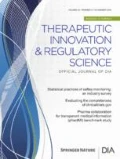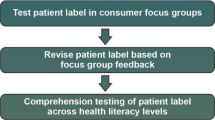Abstract
Background
Print pharmaceutical advertisements in the United States require inclusion of a brief summary of side effects, warnings, precautions, and contraindications from the labeling. The full package insert, which sponsors have traditionally used to fulfill the brief summary requirement, does not adhere to health literacy best practices, limiting its value to consumers. This study compared the understandability and usability of brief summaries in 3 formats designed to be more consumer friendly.
Methods
Three brief summary formats were tested: (1) 2-column “Question and Answer”; (2) “Prescription Drug Facts Box,” similar to current US over-the-counter drug facts labeling; and (3) “Health Literacy,” based on clear communication principles. Researchers evaluated the formats using the Suitability Assessment of Materials (SAM) tool and conducted structured, scripted, one-on-one interviews (usability tests) with participants with estimated low to average education levels. This research was replicated across 2 therapeutic areas (type 2 diabetes and plaque psoriasis).
Results
SAM scores showed that the Health Literacy format outperformed the Question and Answer format and the Prescription Drug Facts Box format in both therapeutic areas, with both Health Literacy brief summaries rated on the SAM as “superior.” Qualitative usability tests supported the SAM findings, with the Health Literacy format preferred consistently over the Question and Answer format, and more often than not over the Prescription Drug Facts Box format.
Conclusions
Sponsors can employ a user-tested Health Literacy format to improve the understandability and usability of brief summaries with patients.
Similar content being viewed by others
References
Institute of Medicine of the National Academies. Health Literacy: A Prescription to End Confusion. Washington, DC: National Academies Press; 2004.
Rudd RE, Anderson JE, Oppenheimer S, Nath C. Health literacy: an update of public health and medical literature. In: Comings JP, Garner B, Smith C, eds. Review of Adult Learning and Literacy. Vol. 7. Mahwah, NJ: Lawrence Erlbaum Associates; 2007:175–203.
Berkman ND, Sheridan SL, Donahue KE, et al. Health literacy interventions and outcomes: an updated systematic review. Evid Rep Technol Assess (Full Rep). 2011;199:1–941.
Smith MY, Wallace LS. Reducing drug self-injection errors: a randomized trial comparing a “standard” versus “plain language” version of Patient Instructions for Use. Res Social Adm Pharm. 2013;9:621–625.
Neuhauser L. Integrating participatory design and health literacy to improve research and interventions. Inform Serv Use. 2017;37:153–176. http://content.iospress.com/download/information-services-and-use/isu829?id=information-services-and-use%2Fisu829. Accessed August 16, 2017.
Rudd RE. Improving Americans’ health literacy. N Engl J Med. 2010;363:2285–2285.
DeWalt DA, Callahan LF, Hawk VH, et al. Health literacy universal precautions toolkit, 2010. https://www.ahrq.gov/professionals/quality-patient-safety/quality-resources/tools/literacy-toolkit/index.html. Accessed August 16, 2017.
European Commission. Guideline on the readability of the labelling and package leaflet of medicinal products for human use, 2009. http://ec.europa.eu/health/files/eudralex/vol-2/c/2009_01_12_readability_guideline_final_en.pdf. Accessed August 16, 2017.
Fischoff B, Brewer NT, Downs JS, eds. Communicating Risks and Benefits: An Evidence-Based User’s Guide. Silver Spring, MD: Food and Drug Administration, US Department of Health and Human Services; 2011. http://www.fda.gov/downloads/AboutFDA/ReportsManualsForms/Reports/UCM268069.pdf. Accessed August 16, 2017.
Wolka A, Simpson K, Lockwood K, Neuhauser L. Focus on health literacy: recommendations to improve European Union risk management plan summaries. Therapeutic Innovation & Regulatory Science. 2015;49:369–376.
Raynor DK, Bryant D. European Public Assessment Report (EPAR) summaries for the public—are they fit for purpose? A user testing study. BMJ Open. 2013;3:e003185.
Hochhauser M. Which prescription for the illegible and unreadable DTC (direct-to-consumer) brief summary—major surgery or euthanasia? Manag Care Q. 2002;10:6–10.
Riggs DL, Holdsworth SM, McAvoy DR. Perspective: direct-to-consumer advertising: developing evidence-based policy to improve retention and comprehension. Health Aff. 2004;23:w249–w252.
Stotka JL, Rotelli MD, Dowsett SA, et al. A new model for communicating risk information in direct-to-consumer print advertisements. Drug Inform J. 2007;41:111–120.
Aikin KJ, O’Donoghue AC, Swasy JL, Sullivan HW. Randomized trial of risk information formats in direct-to-consumer prescription drug advertisements. Med Decis Making. 2011;31:E23–E33.
Sullivan HW, O’Donoghue AC, Aikin KJ. Communicating benefit and risk information in direct-to-consumer print advertisements: a randomized study. Therapeutic Innovation & Regulatory Science. 2015;49:493–502.
Food and Drug Administration. Brief summary and adequate directions for use: disclosing risk information in consumer-directed print advertisements and promotional labeling for prescription drugs. Guidance for industry. Revised draft guidance (revision 2), 2015. http://www.fda.gov/downloads/drugs/guidancecomplianceregulatoryinformation/guidances/ucm069984.pdf. Accessed August 16, 2017.
Wolf MS, Bailey SC, Serper M, et al. Comparative effectiveness of patient-centered strategies to improve FDA medication guides. Med Care. 2014;52:781–789.
Centers for Disease Control and Prevention. Health literacy for public health professionals, 2011. https://www.train.org/cdctrain/course/1057675/. Accessed August 16, 2017.
Doak CC, Doak LG, Root JH. Teaching Patients with Low Literacy Skills. 2nd ed. Philadelphia, PA: JB Lippincott Company; 1996. http://www.hsph.harvard.edu/healthliteracy/resources/teaching-patients-with-low-literacy-skills/. Accessed August 16, 2017.
Mayer G, Villaire M. Health Literacy in Primary Care: A Clinician’s Guide. New York, NY: Springer; 2007.
Osborne H. Health Literacy from A to Z: Practical Ways to Communicate Your Health Message. Sudbury, MA: Jones and Bartlett Publishers; 2005.
Nielsen J. Designing Web Usability: The Practice of Simplicity. Indianapolis, IN: New Riders Publishing; 2000.
Chew LD, Bradley KA, Boyko EJ. Brief questions to identify patients with inadequate health literacy. Fam Med. 2004;36:588–594.
Author information
Authors and Affiliations
Corresponding author
Electronic supplementary material
Rights and permissions
About this article
Cite this article
Sharp, M.L., Hall, L., Eleftherion, A. et al. Comparison of Brief Summary Formats Through a Health Literacy Lens. Ther Innov Regul Sci 53, 100–109 (2019). https://doi.org/10.1177/2168479018769291
Received:
Accepted:
Published:
Issue Date:
DOI: https://doi.org/10.1177/2168479018769291




